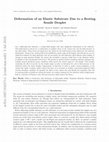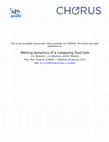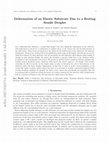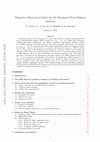Papers by Michael Shearer
arXiv (Cornell University), Aug 30, 2019
Soft materials are known to deform due to a variety of mechanisms, including capillarity, buoyanc... more Soft materials are known to deform due to a variety of mechanisms, including capillarity, buoyancy, and swelling. In this paper, we present experiments on polyvinylsiloxane gel threads partially-immersed in three liquids with different solubility, wettability, and swellability. Our results demonstrate that deformations due to capillarity, buoyancy, and swelling can be of similar magnitude as such threads come to static equilibrium. To account for all three effects being present in a single system, we derive a model capable of explaining the observed data and use it to determine the force law at the three-phase contact line. The results show that the measured forces are consistent with the expected Young-Dupré equation, and do not require the inclusion of a tangential contact line force.

Ima Journal of Applied Mathematics, May 5, 2020
Fluid droplets can be induced to move over rigid or flexible surfaces under external or body forc... more Fluid droplets can be induced to move over rigid or flexible surfaces under external or body forces. We describe the effect of variations in material properties of a flexible substrate as a mechanism for motion. In this paper, we consider a droplet placed on a substrate with either a stiffness or surface energy gradient and consider its potential for motion via coupling to elastic deformations of the substrate. In order to clarify the role of contact angles and to obtain a tractable model, we consider a 2D droplet. The gradients in substrate material properties give rise to asymmetric solid deformation and to unequal contact angles, thereby producing a force on the droplet. We then use a dynamic viscoelastic model to predict the resulting dynamics of droplets. Numerical results quantifying the effect of the gradients establish that it is more feasible to induce droplet motion with a gradient in surface energy. The results show that the magnitude of elastic modulus gradient needed to induce droplet motion exceeds experimentally feasible limits in the production of soft solids and is therefore unlikely as a passive mechanism for cell motion. In both cases, of surface energy or elastic modulus, the threshold to initiate motion is achieved at lower mean values of the material properties.

arXiv (Cornell University), Jul 5, 2016
On a sufficiently-soft substrate, a resting fluid droplet will cause significant deformation of t... more On a sufficiently-soft substrate, a resting fluid droplet will cause significant deformation of the substrate. This deformation is driven by a combination of capillary forces at the contact line and the fluid pressure at the solid surface. These forces are balanced at the surface by the solid traction stress induced by the substrate deformation. Young's Law, which predicts the equilibrium contact angle of the droplet, also indicates an a priori radial force balance for rigid substrates, but not necessarily for soft substrates which deform under loading. It remains an open question whether the contact line transmits a non-zero radial force to the substrate surface in addition to the conventional vertical force. We present an analytic Fourier transform solution technique that includes general interfacial energy conditions which govern the contact angle of a 2D droplet. This includes evaluating the effect of gravity on the droplet shape in order to determine the correct fluid pressure at the substrate surface for larger droplets. Importantly, we find that in order to avoid a strain singularity at the contact line under a nonzero radial contact line force, it is necessary to include a previously-neglected radial traction boundary condition. To quantify the effects of the contact line and identify key quantities that will be experimentally-accessible for testing the model, we evaluate solutions for the substrate surface displacement field as a function of Poisson's ratio and zero/non-zero radial contact line forces.

Journal of Fluid Mechanics
Classical theories for suspensions have been formulated by starting from the Navier–Stokes equati... more Classical theories for suspensions have been formulated by starting from the Navier–Stokes equations describing pure liquid flow and then introducing additional dependencies to account for the presence of suspended particles. These models are often accurate for low particle concentrations but have lacked a convincing description of the frictional interactions of particles, which are important at larger solid volume fractions. The $\mu (J), \varPhi (J)$ rheology, which draws a direct analogy between suspension flow and dry granular flow, is a recent theory that addresses this issue, but is shown here to be dynamically ill-posed for large solid volume fractions. An alternative well-posed theory is introduced that includes additional dependence on the particle-phase dilation and compression. The new theory, denoted vCIDR, is tested numerically to show grid convergence for problems in which the $\mu (J), \varPhi (J)$ rheology instead suffers from catastrophic blow-up. A further well-pos...
The IMA Volumes in Mathematics and Its Applications, 1990
Journal of Fluid Mechanics, Jul 15, 2019

Physical Review Fluids, 2017
The collapse dynamics of an axisymmetric fluid cavity that wets the bottom of a rotating bucket b... more The collapse dynamics of an axisymmetric fluid cavity that wets the bottom of a rotating bucket bound by vertical sidewalls are studied. Lubrication theory is applied to the governing field equations for the thin film to yield an evolution equation that captures the effect of capillary, gravitational and centrifugal forces on this converging flow. The focus is on the quasi-static spreading regime, whereby contact-line motion is governed by a constitutive law relating the contact-angle to the contact-line speed. Surface tension forces dominate the collapse dynamics for small holes with the collapse time appearing as a power law whose exponent compares favorably to experiments in the literature. Gravity accelerates the collapse process. Volume dependence is predicted and compared with experiment. Centrifugal forces slow the collapse process and lead to complex dynamics characterized by stalled spreading behavior that separates the large and small hole asymptotic regimes.
Nonlinear PDE’s, Dynamics and Continuum Physics, 2000

European Journal of Applied Mathematics, 2017
On a sufficiently soft substrate, a resting fluid droplet will cause significant deformation of t... more On a sufficiently soft substrate, a resting fluid droplet will cause significant deformation of the substrate. This deformation is driven by a combination of capillary forces at the contact line and the fluid pressure at the solid surface. These forces are balanced at the surface by the solid traction stress induced by the substrate deformation. Young's Law, which predicts the equilibrium contact angle of the droplet, also indicates an a priori radial force balance for rigid substrates, but not necessarily for soft substrates that deform under loading. It remains an open question whether the contact line transmits a non-zero force tangent to the substrate surface in addition to the conventional normal (vertical) force. We present an analytic Fourier transform solution technique that includes general interfacial energy conditions, which govern the contact angle of a 2D droplet. This includes evaluating the effect of gravity on the droplet shape in order to determine the correct f...
Lecture Notes in Physics
Without Abstract
Journal of Dynamics and Differential Equations, 1991
Proceedings of Symposia in Applied Mathematics, 2009

Long time dynamics of the smoothed step initial value problem or dispersive Riemann problem for t... more Long time dynamics of the smoothed step initial value problem or dispersive Riemann problem for the Benjamin-Bona-Mahony (BBM) equation ut + uux = uxxt are studied using asymptotic methods and numerical simulations. The catalog of solutions of the dispersive Riemann problem for the BBM equation is much richer than for the related, integrable, Korteweg-de Vries equation ut +uux +uxxx = 0. The transition width of the initial smoothed step is found to significantly impact the dynamics. Narrow width gives rise to rarefaction and dispersive shock wave (DSW) solutions that are accompanied by the generation of two-phase linear wavetrains, solitary wave shedding, and expansion shocks. Both narrow and broad initial widths give rise to two-phase nonlinear wavetrains or DSW implosion and a new kind of dispersive Lax shock for symmetric data. The dispersive Lax shock is described by an approximate self-similar solution of the BBM equation whose limit as t → ∞ is a stationary, discontinuous weak...
Siam Journal on Applied Mathematics, Jul 26, 2006
Commun Part Diff Equat, 1995
This paper is a study of certain fully nonlinear 2×2 systems of partial differential equations in... more This paper is a study of certain fully nonlinear 2×2 systems of partial differential equations in one space variable and time. The nonlinearity contains a term proportional to |∂U/∂x| where U = U(x,t) $isinv; ℝ is the unknown function and |·| is the Euclidean norm on ℝ; i.e., a term homogeneous of degree 1 in ∂U/∂x and singular at the origin. Such equations are motivated by hypoplasticity. The paper introduces a notion of hyperbolicity for such equations and, in the hyperbolic case, proves existence of solutions for two initial value problems admitting similarity solutions: the Riemann problem and the scale-invariant problem. Uniqueness is addressed in a companion paper.
This volume will be of interest to applied mathematicians, to researchers in Partial Differential... more This volume will be of interest to applied mathematicians, to researchers in Partial Differential Equations, and to those involved in Fluid Dynamics and Numerical Analysis examining models for viscoelastic flows, porous medium and granular flows, and flows ...
Mathematical Proceedings of the Cambridge Philosophical Society
ABSTRACT
Israel Journal of Mathematics
ABSTRACT
Uploads
Papers by Michael Shearer